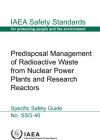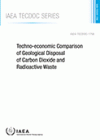Nuclear waste must be processed to make it safe for disposal. This includes its collection and sorting; reducing its volume and changing its chemical and physical composition, such as concentrating liquid waste; and finally, its conditioning so it is immobilized and packaged before storage and disposal.
Processing
Before selecting a waste processing strategy, it is essential to know and understand the waste source and rate of waste generation, as well as the amounts and characteristics of the waste. Characterization is a technique that provides information on the physical, chemical and radiological properties of the waste, which helps identify appropriate safety requirements and potential processing options. It also ensures compatibility and compliance with accepted storage and disposal criteria.
There are three main steps in the processing of nuclear waste: pre-treatment, treatment and conditioning.
Pre-treatment prepares the waste for processing and may include sorting and segregation to separate out contaminated items from non-contaminated ones. Sometimes it is necessary to reduce the size of the waste by, for example, cutting or shredding it to optimize its downstream processing. Decontamination techniques reduce the volume of waste requiring treatment, which in turn minimizes the cost of its disposal.
Once the waste is suitably prepared, the next step is treatment to enhance its safety and reduce the costs of further management phases, such as storage or disposal. Generally, treatment processes tend to reduce the volume or radioactive waste by separating out the radioactive component from the bulk waste, often changing the waste’s composition in the process. A variety of waste treatment processing steps are available for use, depending on the nature of the waste and the waste acceptance requirements of the chosen disposal site. Two common treatment techniques are: incineration of solid waste and evaporation of liquid waste.
The third step in the process – conditioning – brings the waste into a safe, stable and manageable form so it can be transported, stored and disposed. Conditioning techniques are designed to slow the release of radionuclides from the disposed waste package into the environment. To condition waste for disposal, it is often encapsulated or solidified in cement, bitumen or glass, or over-packed into special containers.
Providing a safety framework for radioactive waste and spent fuel management
The IAEA assists its Member States in establishing a proper safety framework for the management of radioactive waste and spent fuel. It develops Safety Standards for the predisposal management of radioactive waste and spent fuel and supports Member States in applying them. The Agency also coordinates the Waste Safety Standards Committee, which is one of five IAEA Safety Standards Committees. It has the goal to provide feedback and recommendations to the Agency on its waste safety programmes.
In addition, the IAEA provides the Secretariat for the meetings of the Contracting Parties of the Joint Convention on the Safety of Spent Fuel Management and on the Safety of Radioactive Waste Management.
The Agency regularly organizes international projects and working groups to work towards a harmonization of approaches for the safety of predisposal management of radioactive waste. These events also provide a forum of exchange for Member States.
The IAEA covers a wide range of predisposal management topics, such as policy and strategy; inventory assessment; analysis of costing and waste management economics; waste minimization; improvement in operating practices at nuclear facilities; and the development of waste management technologies. It is also involved in international projects on the issue, one of which is the CRAFT project. This initiative deals with the demonstration of safety of predisposal facilities.
The Agency delivers assistance to Member States through its LABONET and IPN networks and its technical cooperation programme.








